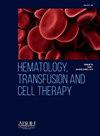晚期头颈部鳞状细胞癌的诱导化疗:真实世界数据研究
IF 1.8
Q3 HEMATOLOGY
引用次数: 0
摘要
大约60%的HNSCC患者被诊断为局部或局部区域晚期。局部或局部进展期且不适于手术切除的患者接受放化疗(CTRT)作为最终治疗,或诱导化疗(ICT)随后或不进行CTR。在最后一篇文章中,多西紫杉醇加顺铂(TP)和多西紫杉醇加顺铂加5-氟尿嘧啶(TPF)加CTRT首次被描述为具有可接受安全性的有效ict方案。尽管TPF在缓解率、局部区域控制和晚期HNSCC患者的生存方面优于TP,但该方案明显存在缺点,如3级或以上不良事件,需要输液器或住院床位持续输注5-氟尿嘧啶,这显然增加了治疗成本。目的:本研究旨在分析坎皮纳斯大学总医院局部地区晚期HNSCC患者在TPF或TP治疗后再进行CTRT治疗,目的是开发一种适用于资源有限的服务的ICT协议。材料和方法纳入2015年1月14日至2021年11月24日期间接受ICT治疗的III期或IVA-B期(T4和/或N2b、N2c或N3) HNSCC患者,TPF或TP加CTRT。TPF和TP作为诱导化疗(ICT)的选择是基于负责肿瘤学家的临床判断,考虑患者的具体因素,如身体状况、合并症和对强化方案的耐受性。此外,是否有病床供5-氟尿嘧啶持续静脉输注也是一个实际的决定因素。对两组患者的毒性、反应率、无事件生存期(EFS)和总生存期(OS)进行评估。采用Kaplan-Meier曲线和log-rank检验评估无事件生存期(EFS)和总生存期(OS)。通过单因素和多因素Cox回归评估临床病理特征对患者生存的影响。结果87例HNSCC患者行ICT治疗,其中TPF治疗38例,TP治疗49例。TPF组ECOG 0或1值过高,TP组男性ECOG 0或1值过高,但TPF和TP治疗的患者在年龄、吸烟和饮酒、体重指数、肿瘤位置、分级和TNM分期、毒性3级及以上、治疗反应和周期间隔等方面无显著差异。中位随访时间为22.6个月(范围:1.2 - 93.8)。两组患者2年和5年的EFS发生率分别为33.8%和25.3%。ICT方案没有改变对ICT的反应,以及患者的EFS和OS。Cox多因素分析发现,稳定或进展的疾病(HR: 5.56)和周期间隔≥28天(HR: 2.79)是较低EFS的预测因素,ECOG≥1 (HR: 3.42)、稳定或进展的疾病(HR: 4.67)和周期间隔≥28天(HR: 2.73)是较低OS的预测因素。结论TP是局部晚期HNSCC的良好治疗选择,特别是在社会经济条件有限的地区。本文章由计算机程序翻译,如有差异,请以英文原文为准。
INDUCTION CHEMOTHERAPY IN ADVANCED HEAD AND NECK SQUAMOUS CELL CARCINOMA: A REAL-WORLD DATA STUDY
Introduction/Justification
Approximately 60% of HNSCC patients are diagnosed at a locally or locoregionally advanced stage. Patients with locally or locoregionally advanced stage and not amenable to surgical resection receive chemoradiotherapy (CTRT) as definitive treatment, or induction chemotherapy (ICT) followed or not by CTR. In the last scenery, docetaxel plus cisplatin (TP) and docetaxel plus cisplatin plus 5-fluorouracil (TPF) followed by CTRT were first described as effective ICTs regimens with acceptable safety profile. Despite the superiority of TPF over TP in response rate, loco-regional control, and survival of patients with advanced HNSCC, unequivocal disadvantages have been attributed to the regimen, as grade 3 or above adverse events, and the need of infusion devices or inpatient beds for continuous 5-fluorouracil infusion, which clearly increases the costs of treatment.
Objectives
The current study aimed to analyze patients with locoregionally advanced HNSCC treated with TPF or TP followed by CTRT at the General Hospital of the University of Campinas, with the purpose of developing an ICT protocol applicable to services with limited resources.
Materials and Methods
Patients with HNSCC at stage III or IVA-B (T4 and/or N2b, N2c or N3) treated with ICT using TPF or TP followed by CTRT from January 14 th, 2015, to November 24 th, 2021, were included in the study. The choice between TPF and TP as induction chemotherapy (ICT) was based on the clinical judgment of the responsible oncologist, considering patient-specific factors such as performance status, comorbidities, and tolerance to intensive regimens. Additionally, the availability of a hospital bed for the continuous intravenous infusion of 5-fluorouracil was a practical determinant. Toxicity, response rate, and event-free survival (EFS) and overall survival (OS) were evaluated in patients of both groups. Event-free survival (EFS) and overall survival (OS) were assessed using the Kaplan-Meier curves and the log-rank test. The impact of clinicopathological characteristics on patients’ survival was assessed through univariate and multivariate Cox regression.
Results
Eighty-seven patients with HNSCC were treated with ICT, being 38 with TPF and 49 with TP. An excess of ECOG 0 or 1 was seen in TPF group and an excess of males in TP group, but no significant differences in age, smoking and alcohol intake, body mass index, tumor location, grade and TNM stage, toxicities grade 3 or above, treatment response, and cycles interval, were seen in patients treated with TPF and TP. The median follow-up time was 22.6 months (range: 1.2 to 93.8). The two-year and five-year EFS rates of patients of the total group were 33.8% and 25.3%, respectively. ICT regimens did not alter response to ICT, and patients’ EFS and OS. Cox multivariate analysis identified stable or progressive disease (HR: 5.56) and interval between cycles ≥ 28 days (HR: 2.79) as predictors of lower EFS, and ECOG ≥ 1 (HR: 3.42), stable or progressive disease (HR: 4.67), and interval between cycles ≥ 28 days (HR: 2.73) as predictors of lower OS.
Conclusion
Our findings indicate TP as a good treatment option for locoregionally advanced HNSCC, especially in socioeconomically limited settings.
求助全文
通过发布文献求助,成功后即可免费获取论文全文。
去求助
来源期刊

Hematology, Transfusion and Cell Therapy
Multiple-
CiteScore
2.40
自引率
4.80%
发文量
1419
审稿时长
30 weeks
 求助内容:
求助内容: 应助结果提醒方式:
应助结果提醒方式:


